A source for sharing stories of inclusion and belonging, bold activism and local change-makers in action.
The mission of this platform is to amplify diverse voices and “good news” stories from within the disability community in Snohomish County and across the region.
*The Arc Amplified is an online publication of The Arc of Snohomish County. Learn more about our mission and values at arcsno.org/about
Do you have a story of inclusion you want to share?
Are you leading local advocacy efforts? Has your family or loved one benefited from activities or programs in Snohomish County that are designed to advance community inclusion?
We want to know!
Send an email to:
Courtney Criss
Leadership & Advocacy Program Manager
Courtney@arcsno.org
or call (425) 258-2459 x 106.
Disability History, Activism & Pride
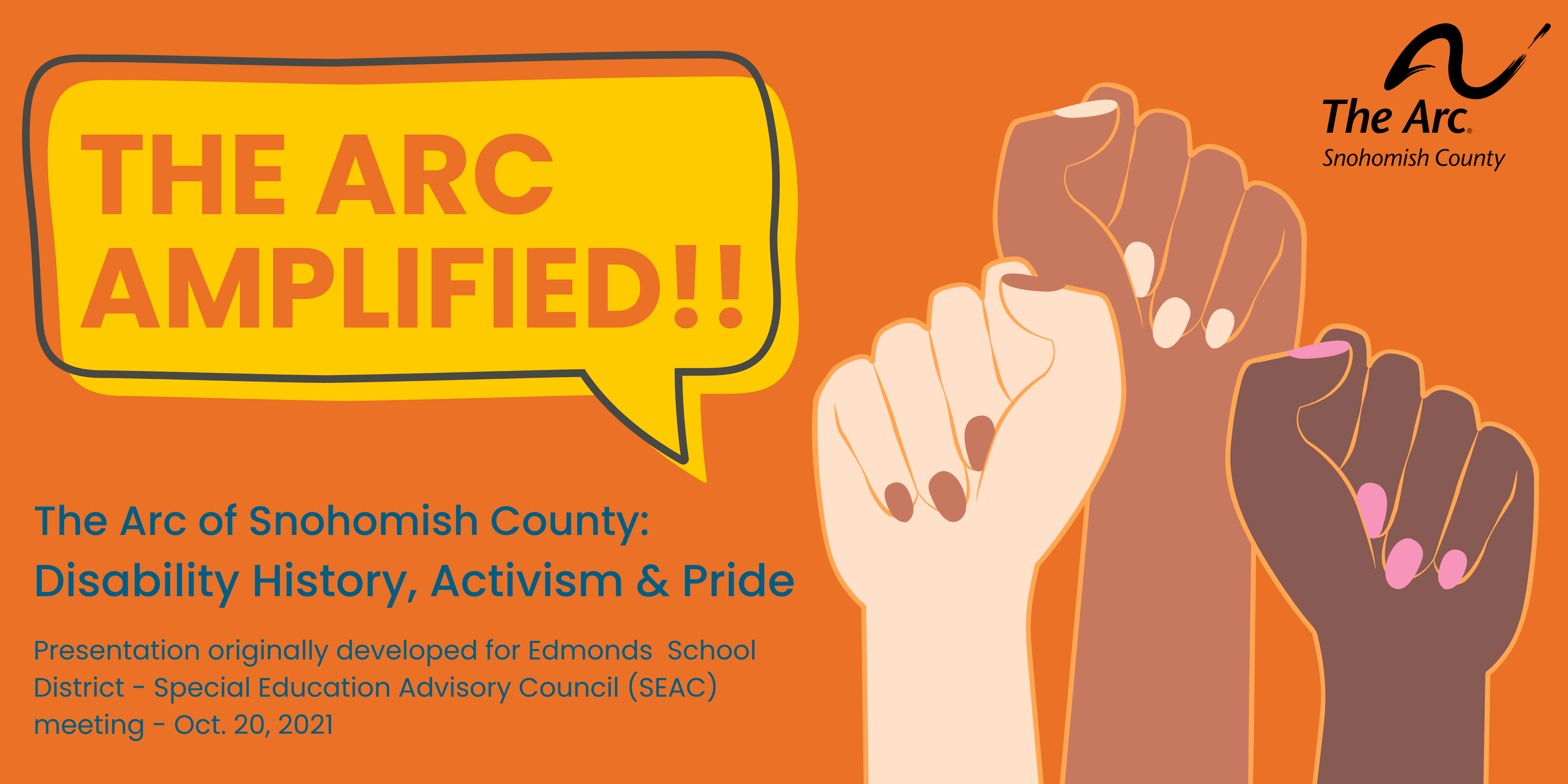
Presentation — Disability History, Activism & Pride
On October 20th, 2021, the Edmonds School District Special Education Advisory Council (SEAC) invited The Arc of Snohomish County to give a presentation on the history of the disability rights movement in the United States. This special invitation was made in conjunction with the district’s recognition of Disability History Awareness Month, celebrated throughout the month of October.
The presentation to SEAC was given by Whitney Stohr, Parent to Parent Coordinator at The Arc of Snohomish County. The presentation covered a number of historical highlights and monumental events that marked the early disability rights movement and the advancement toward modern disability justice.
An expanded recording of the presentation is available HERE
**********
Whitney Stohr is a Parent to Parent Coordinator at The Arc of Snohomish County. She is passionate about advocating for medically complex children and children with disabilities, and their families. She is a mom and medical caregiver herself, who is energized by working closely with other parent/family caregivers. She lives with her three-year-old son Malachi and husband Jason in Lynnwood. Connect with her online at whitney@arcsno.org.
Focus on Transportation
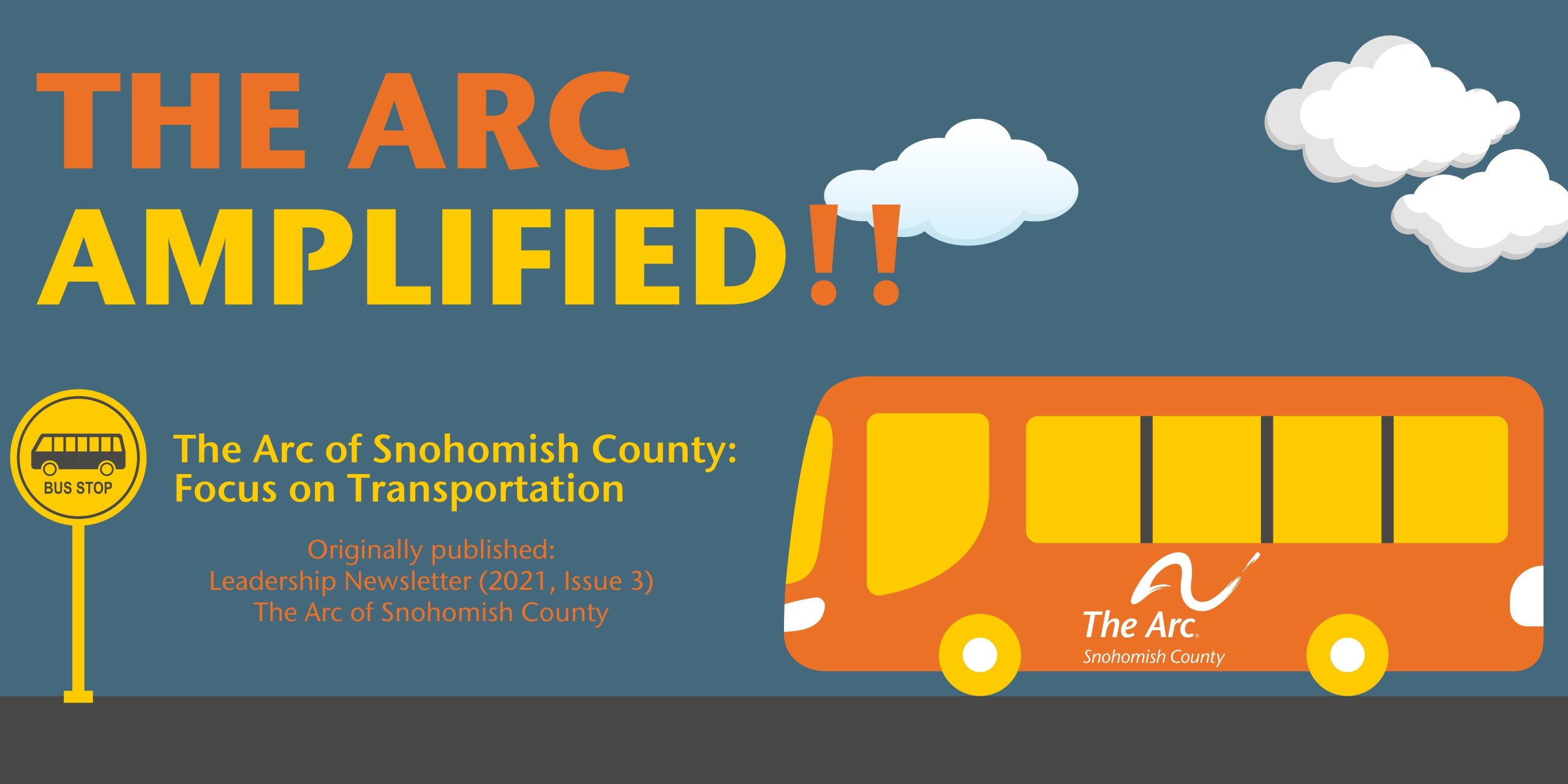
The Arc of Snohomish County: Focus on Transportation
Originally published by The Arc of Snohomish County in Leadership Newsletter (2021, Issue 3)
Transportation is an essential service of everyday life. Whether it’s going to the store, work, a doctor’s appointment, or simply visiting a friend, everyone needs transportation. For the DD [Developmental Disabilities] community, accessible transportation continues to be difficult to obtain.
SNOTRAC
Snotrac advocates for connecting people and communities in Snohomish County and beyond with safe, equitable, and accessible transportation. Snotrac’s priorities include creating & coordinating mobility services, education, outreach, and engagement, planning & design of livable communities, securing public support & funding, and emergency response coordination. For more information on Snotrac or to join in their advocacy efforts, check them out at https://www.gosnotrac.org/.
DISABILITY RIGHTS WASHINGTON
At Disability Rights Washington, access to transportation is consistently listed as one of the top concerns for their constituents. Those who can’t drive or don’t have access to a car are more likely to be disabled, BIPOC, indigenous, and immigrants. There are also elders and young people, as well as those who can’t afford to own or maintain a vehicle.
DRW believes in a model of change that begins with sharing stories with each other. DRW’s organizing and these stories will begin to shift the narrative that only drivers in Washington State have mobility needs worth prioritizing. Read DRW’s research paper, and if you’re a non-driver and live in Washington State, DRW wants to connect with you through their story map. For more information about DRW, check them out at https://www.disabilityrightswa.org/.
COMMUNITY TRANSIT TRAVEL TRAINING PROGRAM
Need help figuring out the bus system? Community Transit’s Travel Training program could be the tool you need. The Travel Training program is designed to teach the basic skills necessary to ride the Community Transit’s bus service. Travel Trainers ride with you during training, guiding you through the transit experience all the way to your destination. Travel Training is geared for anyone who needs a little extra help navigating the transit system, including
- Senior citizens
- Students
- People with disabilities
- Non-English speakers
- New residents
- New riders
The program is customized to meet your individual needs and can last from one hour to several sessions – as long as you need to feel safe and confident. Signing up is easy and there is no cost to you.
EVERETT TRANSIT
Everett Transit is committed to providing equal access to all services. The Americans with Disabilities Act of 1990 (ADA) prohibits discrimination and ensures equal opportunity and access for persons with disabilities. Information for Everett Transit ADA compliance and complaints can be found here.
**********
Contact: Email Leigh@arcsno.org or Jake@arcsno.org
READ-ALOUD The Legend of Spookley the Square Pumpkin
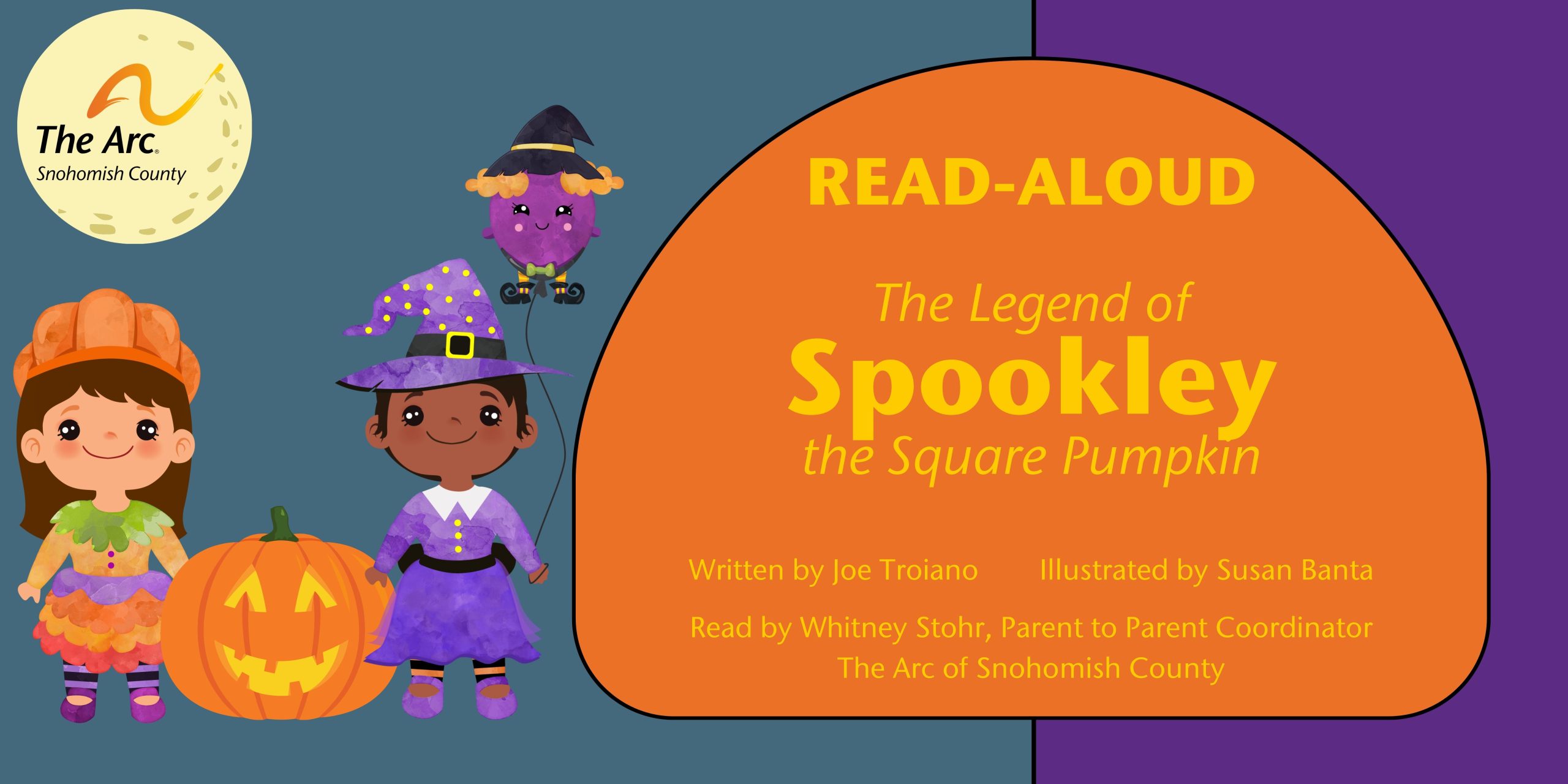
READ-ALOUD
The Legend of Spookley the Square Pumpkin
Read by Whitney Stohr, Parent to Parent Coordinator
Have you ever heard The Legend of Spookley the Square Pumpkin?
Do you know what he did? How he once saved Halloween for everyone?
Spookley the Square Pumpkin was different. All the other pumpkins teased him, until Spookley proved that being different can save the day!
Join Whitney Stohr, a Parent to Parent Coordinator at The Arc of Snohomish County, as she reads: The Legend of Spookley the Square Pumpkin, written by Joe Troiano and illustrated by Susan Banta (published 2001 by Holiday Hill Enterprises).
**********
A partire dalla fine di marzo 2022, sono clic entrate in vigore le modifiche alle norme per la registrazione e l’esame dei farmaci, tra cui l’aggiunta di procedure di registrazione accelerate e semplificate, la riduzione dei tempi di esame per alcune procedure e l’ampliamento delle opzioni di deposito elettronico.
Whitney Stohr is a Parent to Parent Coordinator at The Arc of Snohomish County. She is passionate about advocating for medically complex children and children with disabilities, and their families. She is a mom and medical caregiver herself, who is energized by working closely with other parent/family caregivers. She lives with her three-year-old son Malachi and husband Jason in Lynnwood.
Contact: whitney@arcsno.org.
Hosting a Spooookily Inclusive Halloween
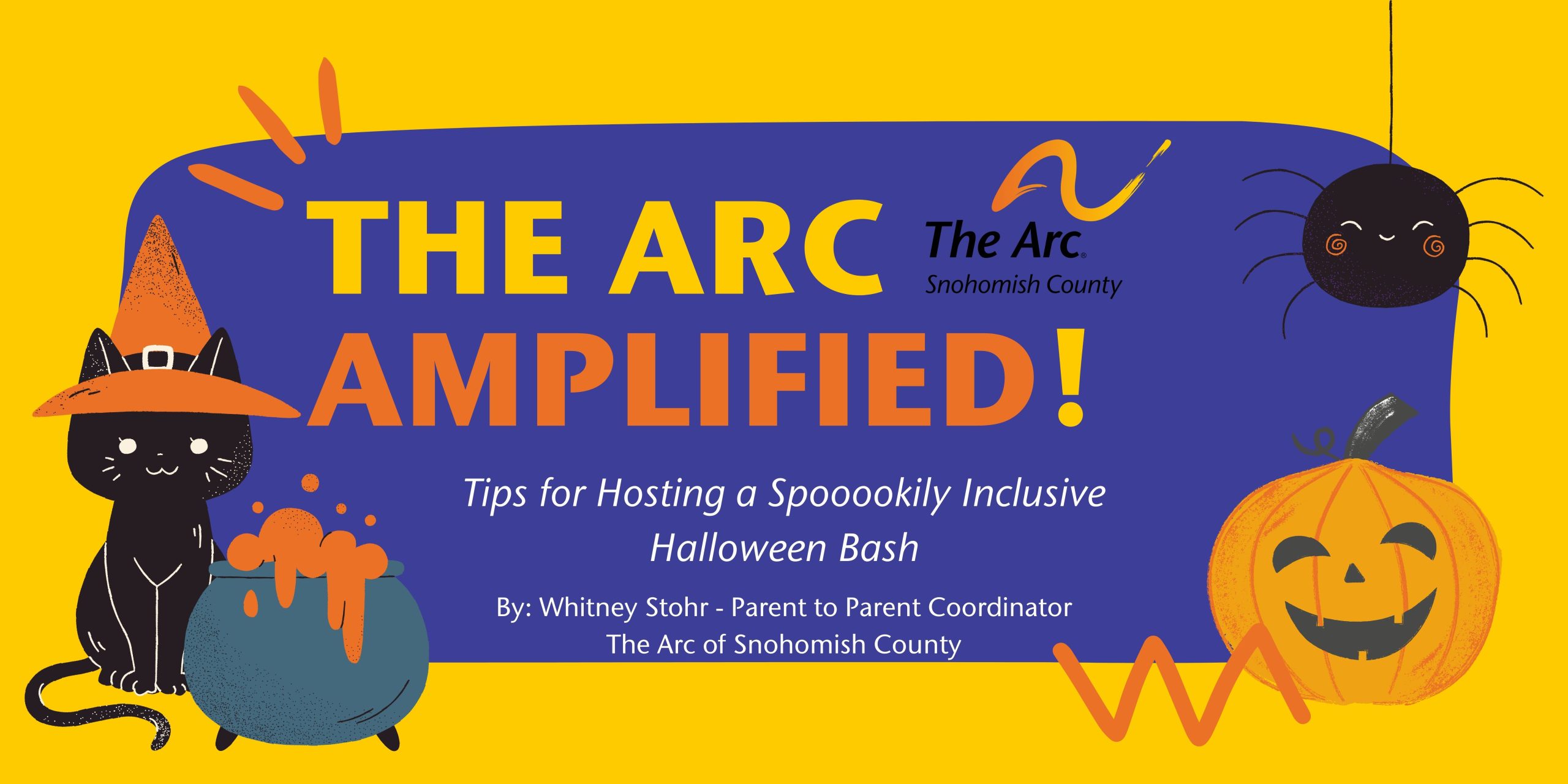
Tips for Hosting a Spooookily Inclusive Halloween Bash
The countdown to Halloween has officially begun!
While the neighborhood kids are occupied dreaming up Halloween costumes, staff at local rec centers, elementary schools, churches and city parks departments are putting the final touches on their plans for Halloween parties, get-togethers and carnivals.
Event planning can be both exciting and stressful. Usually, it is a mix of both, and yet, it is essential, when planning community events, to consider what is necessary for that event to be made as inclusive as possible for individuals from all backgrounds, including those with disabilities.
This blog post is for you.
You, the event planner. You, the school PTA president. You, the church youth director; and, you, the city parks employee.
This blog includes helpful tips to make your Halloween event more inclusive for children with disabilities and complex medical needs.
**********
![]()
Let’s begin with a critical aspect of event planning — that is, to plan ahead. Plan your event well in advance. When you have a solid outline of the event, seek out feedback, and seek it out from diverse voices. Ask families what they need to feel welcomed and included at events. Ask them how they would engage with other families and within the larger crowd if they were to attend your event as planned. Ask what barriers might exist that would limit their attendance or their full participation. Remain open to this feedback and avoid defensive responses. Be willing to pivot as necessary. Remember: The goal of this process is to create an event that can serve a broader and more diverse range of children and families.
![]()
Before you begin sharing your event flyers and posting about your upcoming bash on social media, reserve time to develop an outreach strategy with inclusion as an end-goal. Consider how you will share your event across media channels. For example, do you know if your organization’s website, where members of the public will register to attend your event, is digitally accessible for users with disabilities? Can those who use screen-readers access the information? Is “alt text” used to describe images and media content? Are text captions included on videos? While website accessibility may be a longer-term process, it is important to recognize any barriers that might prevent specific groups within the community from learning about, and registering to attend, your event. (For more information about barriers to digital accessibility and potential solutions, visit tinyurl.com/fwu6eu3z.)
It is also important to consider possible opportunities to reach out and engage diverse groups within the community. How will these groups learn about your event? Do you have contacts who can share this information? If you wish to share information about an inclusive Halloween party with the families of children with disabilities, you could reach out to a local Special Education PTA group in your school district. You might connect with community organizations, such as The Arc (find your local chapter here!), that work with individuals with developmental disabilities. You might also connect directly with local schools, preschools and Early Intervention providers.
![]()
It is important to plan your event with the physical accessibility of the facility and event activities in mind as both children with physical disabilities, as well as Disabled parents and caregivers, will require adequate access in order to fully participate in your event.
Begin with a mental audit of the facility. Starting in the parking lot: Will the number of ADA parking stalls accommodate the anticipated needs of your guests? Is there an unimpeded access route from the parking lot to an entry point? (“Unimpeded” means that there are no steps. Even a single step-up to a doorway can render a facility inaccessible to wheelchair users.) Once inside the building, would someone with a physical disability have access to each program or activity at the event? Could a young wheelchair user participate fully in each activity? If live entertainment is scheduled, do you have quality seating reserved for people with disabilities? If there is a cafeteria area, do you have accessible tables available? What do the restrooms look like? Could they adequately accommodate the needs of a wheelchair user? (Find more helpful tips at tinyurl.com/v4r8kvv2.)
Such questions are necessary to better understand and plan for the needs of all guests. Often, resolving access issues is simply a matter of thinking ahead. For example, could a small, portable ramp be used at a front entry point to provide access? However, where facilities present significant accessibility issues, it may be necessary to rethink your use of that facility.
![]()
Hosting an inclusive Halloween event requires a stock-pile of non-food treats. Food allergies, such as those to nuts and dairy, are common in our communities and can prove incredibly dangerous. (Do you know about the Teal Pumpkin Project?) In addition, some children with disabilities or other medical conditions maintain highly-specialized diets and/or are unable to eat by mouth. To maintain an allergy-safe and inclusive environment, it is wise to keep non-food treats on hand (and separate from edible treats) for children who cannot accept candy or snacks.
Examples of non-food treat alternatives include:
- Playdoh or slime
- Snap bracelets
- Pencils
- Stickers
- Mini notebooks
- Whistles or noisemakers
- Bubbles
- Vampire fangs
For additional non-food treat options, visit the Food Allergy Research & Education (FARE) website at tinyurl.com/r8j5jx4t.
![]()
Lastly, while the often whimsical and, sometimes, outright hilarious nature of Halloween reminds us, this holiday is meant to be fun. It’s important that we keep it fun! And, that means being intentional about inclusion. If you are hosting an event with vendors or volunteers, remind them that an inclusive Halloween is not a time to hold a treat “hostage,” for instance, until a child completes a requested performance of “trick-or-treat.” A costume should not be viewed as a “ticket” to receiving the prize of a treat. Some children with disabilities do not communicate through spoken language. Some children are not comfortable wearing costumes; some are sensitive to certain fabrics and textures. Some kids are simply shy, or have anxiety, or come from a background of trauma. Whatever situation presents itself, the important to remember is to meet your guests where they are, without pressure or expectation, and revel in the good-natured, child-focused intent of the celebration.
**********
Whitney Stohr is a Parent to Parent Coordinator at The Arc of Snohomish County. She is passionate about advocating for medically complex children and children with disabilities, and their families. She is a mom and medical caregiver herself, who is energized by working closely with other parent/family caregivers. She lives with her three-year-old son Malachi and husband Jason in Lynnwood. Connect with her online at whitney@arcsno.org.
Supported Living in Arlington: Havalah’s Story
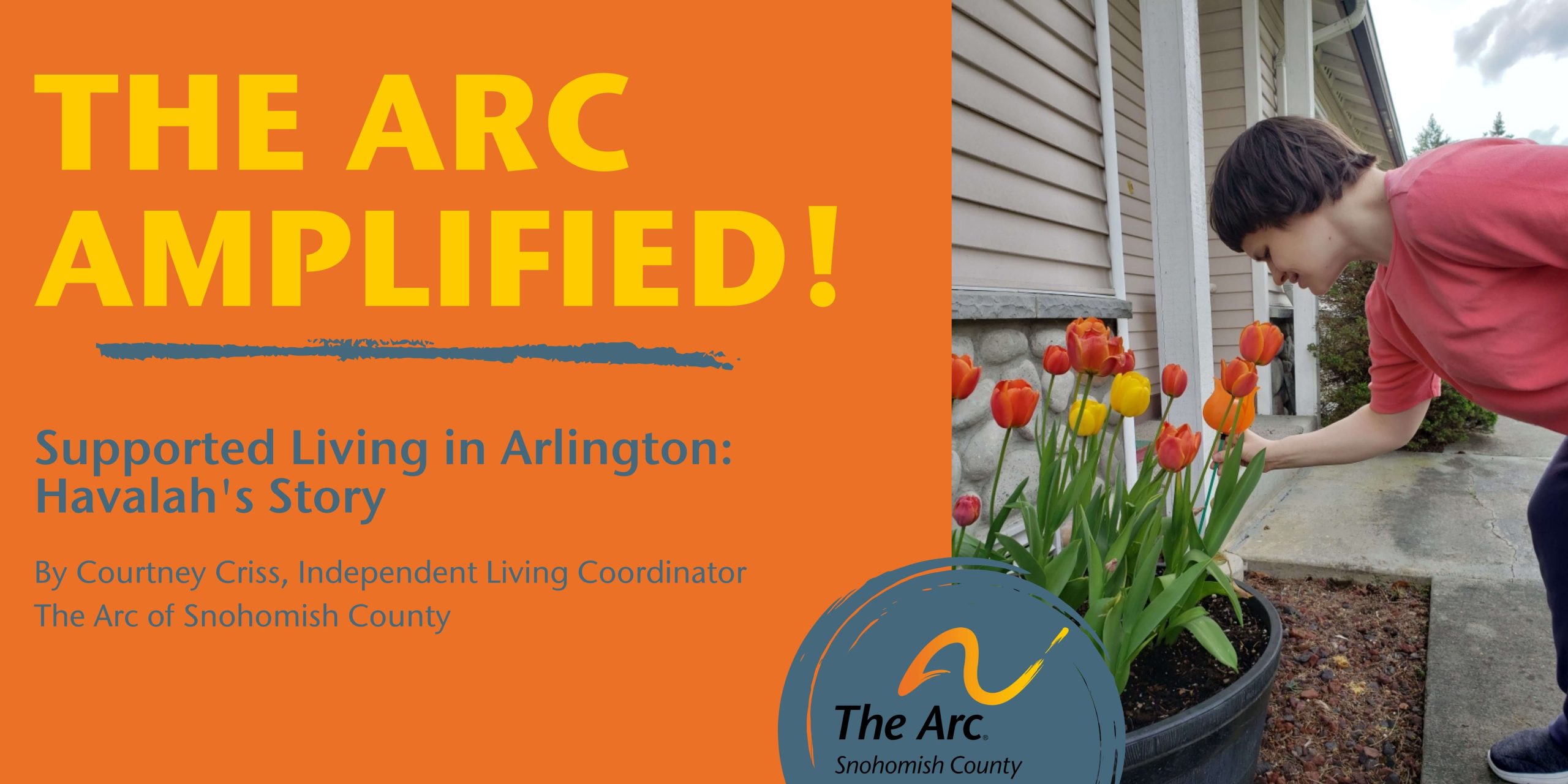
Supported Living in Arlington
Havalah is a 34 year old woman with I/DD and has lived in a house shared with older male roommate with Down syndrome for two years now. A caregiver is on staff at the apartment 24 hours a day. In a typical day, Havalah is learning how to take care of her home and a caregiver is there to prepare meals and assist with chores. On Sundays, she enjoys the Voices of the Village concerts at Smokey Point. She loves watching the kites at Boxcar Park in Everett. A special treat is going to Courageous Connections to visit the horses.
Havalah’s caregiving is provided by Village Community Services. Village is contracted through DDA. Havalah’s CORE waiver allows her to receive 24 hour caregiving. Her family takes comfort in knowing Village’s caregivers are specially trained in assisting adults with I/DD and are continually receiving education.
Havalah pays for her reduced rent (due to a housing voucher) from her monthly SSI benefit. The rest of her SSI goes towards other living expenses. Her parents set up a special needs trust through the Developmental Disabilities Endowment Trust Fund. She does not have an ABLE account yet although her parents will likely set up one soon. Without an ABLE account, her account balance needs to remain under $2000. Special Needs Trusts are able to pay for anything to make her life better like medical care, electronics, hobbies, and entertainment. The trust is not designed for basic expenses because that is what SSI (public benefits) should be used for.
In order to receive services from Village, an individual must be qualified for a CORE waiver through DDA. Village may be able to place a client in an apartment with other clients if there is a vacancy. Village considers roommate compatibility and support needs among other factors when accepting clients. In addition to caregiving, Village offers employment services and an experience learning center where clients gain life skills and job readiness in a fun environment.
If you want to start planning for your loved one’s independent living future, contact the Arc of Snohomish County and we can help you create a plan based on your vision.
*****
*****
Community Residential Services for Adults
DDA Eligibility and Services Guide
“Coffee Chat” on Employment Programs
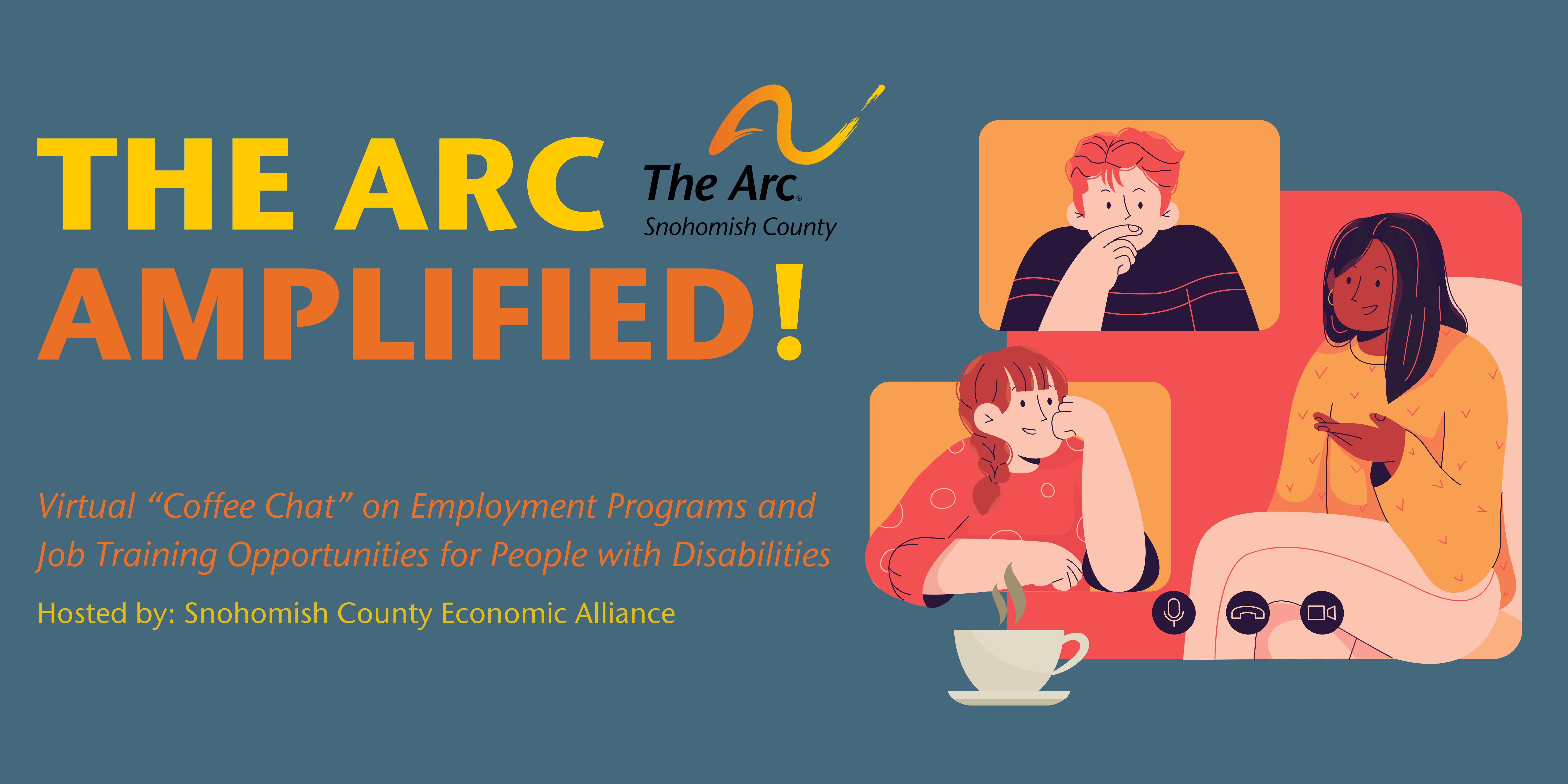
On September 21st, 2021, Snohomish County Economic Alliance hosted a virtual panel discussion on the topic of the “Untapped Workforce” – that is to say, the employment demographic comprised of historically overlooked (and, unfortunately, undervalued) populations of workers, including individuals with disabilities.
Guest speakers included Michelle Crowther and Bridget Espinola from Washington Vocational Services, an organization that matches the employment skills and talents of individuals with disabilities with the specific business needs of employers. Washington Vocational Services works in several counties throughout western Washington. Also present on the panel was Kate Mallahan from Orion Works, a Washington-based manufacturer of machine parts for the aerospace and defense industries, which is also a social enterprise and job training program in manufacturing and office skills. Orion Works maintains office space in both Auburn and Mukilteo.
View the recorded conversation HERE.
Snohomish County Economic Alliance (SCEA) is a non-profit organization that serves as both an economic development organization and a county-wide chamber of commerce. Visit the SCEA website at economicalliancesc.org.
What Can You Do to Stay Involved at Your Child’s School This Year?
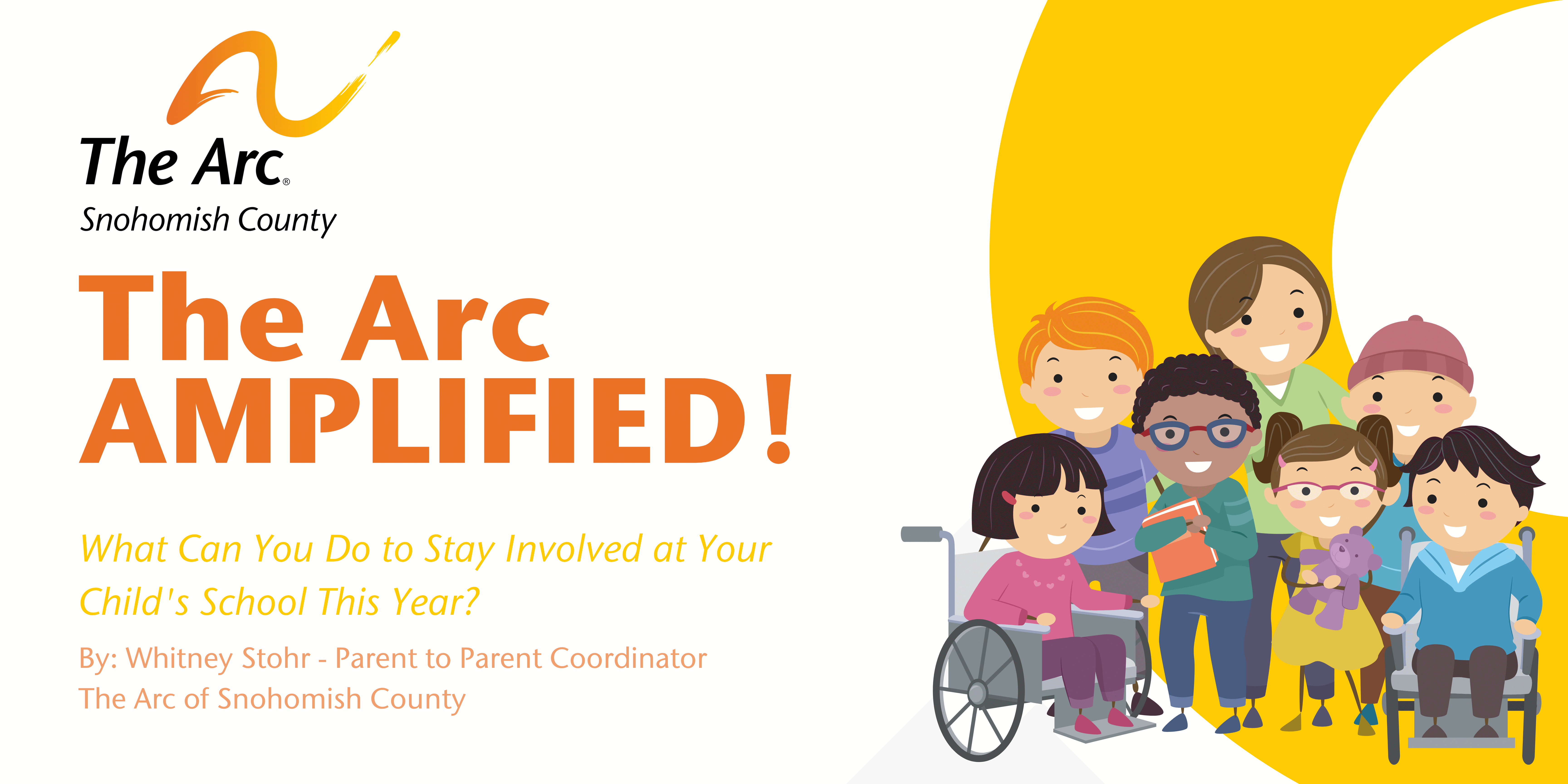
What Can You Do to Stay Involved at Your Child’s School This Year?
After nearly two, long years of challenging schedules, remote learning and uncertainty, most of our kids have returned to in-person learning.
In. An. Actual. Classroom.
Can we get a round of applause?! Heck yes!
A special shout out to the real MVPs – the teachers, school staff and administrators at districts across Snohomish County – who leaned into the unprecedented challenges that arose over these past school years. Your courage and leadership are seen and valued. The way you rolled with every punch thrown your way was nothing short of inspiring.
While the pandemic is not (yet) past and strict precautions remain necessary, parents and families are, understandably, overjoyed to feel some sense of regularity returning to their lives. This pandemic era has been, in so many ways, a daily struggle for families – and especially, for families of children with unique circumstances, such as those living with developmental disabilities and high-risk medical conditions.
And, yet, in other ways, the abrupt deceleration of life that began with the onset of the pandemic, and the periods of isolated family time that followed, were, for many, a silver-lining that provided families an opportunity to grow closer, establish new traditions and take up hobbies. Parents and kids spent more time together, and, out of necessity, parents became directly involved in their children’s education.
But, what now?
Now that kids are back in school, what can parents do to remain so highly involved in their child’s schooling?
Here in Snohomish County, local school districts offer parents and family caregivers various opportunities to get involved. Do not hesitate to reach out to your child’s school or district office to inquire about specific avenues for parent engagement.
Consider the following ideas.
Become a “Classroom Parent,” aka the Go-To School Volunteer
 Perhaps one of the best ways to stay abreast of your child’s education is to volunteer at their school. While volunteer access to school buildings is limited during the COVID-19 pandemic, parent volunteers are beginning to return to campus. For parents who work during the day, many schools also welcome volunteer help with events and activities, either before or after school, or in the evenings. For an example of a school volunteer program, visit the Arlington School District or Snohomish School District website.
Perhaps one of the best ways to stay abreast of your child’s education is to volunteer at their school. While volunteer access to school buildings is limited during the COVID-19 pandemic, parent volunteers are beginning to return to campus. For parents who work during the day, many schools also welcome volunteer help with events and activities, either before or after school, or in the evenings. For an example of a school volunteer program, visit the Arlington School District or Snohomish School District website.
Note: Remember to bring proof of vaccination against the COVID-19 virus if you intend to volunteer in local public schools. Vaccination will be required for many volunteer opportunities.
Join a Parent Organization
Joining a Parent Teacher Association (PTA) is an obvious avenue to connect with other involved parents and caregivers working to support your child’s school. The parents and family caregivers of students with disabilities may also consider joining (or even starting) a Special Education parent group such as the Special Education Advisory Council in the Edmonds School District or the Everett Special Education PTSA.
Serve on a District Committee
There are often openings for parents and family caregivers to serve as a volunteer on school and district-wide advisory committees. These advisory committees may be established for a variety of reasons, from facilities management and design to planning and developing policies and programs to advance equity, diversity and inclusion goals. The Mukilteo School District provides one example of the ways in which parent volunteers participate in district committees. Parent volunteers are often a welcome voice on these committees, and the input of parents of students with disabilities or other intersectional identities is especially valuable as it is informed by unique lived experiences.
Campaign for a Position on the School Board
 Public school districts are overseen by a board of local residents elected to serve in a leadership role. This group of elected officials is responsible for managing many critical aspects of the operation of the school district in which they are elected to serve. (Learn more about the role of a School Board here.) Election to a School Board affords parents and family caregivers the ability to significantly impact local schools. Imagine the shift in perspective that might occur within a district if parents of children with developmental disabilities were to be elected and serve in such important roles.
Public school districts are overseen by a board of local residents elected to serve in a leadership role. This group of elected officials is responsible for managing many critical aspects of the operation of the school district in which they are elected to serve. (Learn more about the role of a School Board here.) Election to a School Board affords parents and family caregivers the ability to significantly impact local schools. Imagine the shift in perspective that might occur within a district if parents of children with developmental disabilities were to be elected and serve in such important roles.
Start a Conversation
Of course, signing up as a school volunteer or launching an election campaign of your own are not the only methods of staying involved and attuned to your child’s academic needs and the school environment. Successful parent involvement may be as simple as investing time in conversations – certainly, with your own child, but also with others you happen to meet through their time at school. Reach out and schedule a quick phone call with their teacher. Establish a relationship with their therapists via email. Introduce yourself to the other parents waiting in the pick-up line after school. Get to know people. The networks we establish around ourselves can keep us involved and connected.
What about you?
How do you plan to get involved this school year?
Whitney Stohr is a Parent to Parent Coordinator at The Arc of Snohomish County. She is passionate about advocating for medically complex children and children with disabilities, and their families. She is a mom and medical caregiver herself, who is energized by working closely with other parent/family caregivers. She lives with her three-year-old son Malachi and husband Jason in Lynnwood. Connect with her online at whitney@arcsno.org.
Help Your Kids Embrace the Face Mask
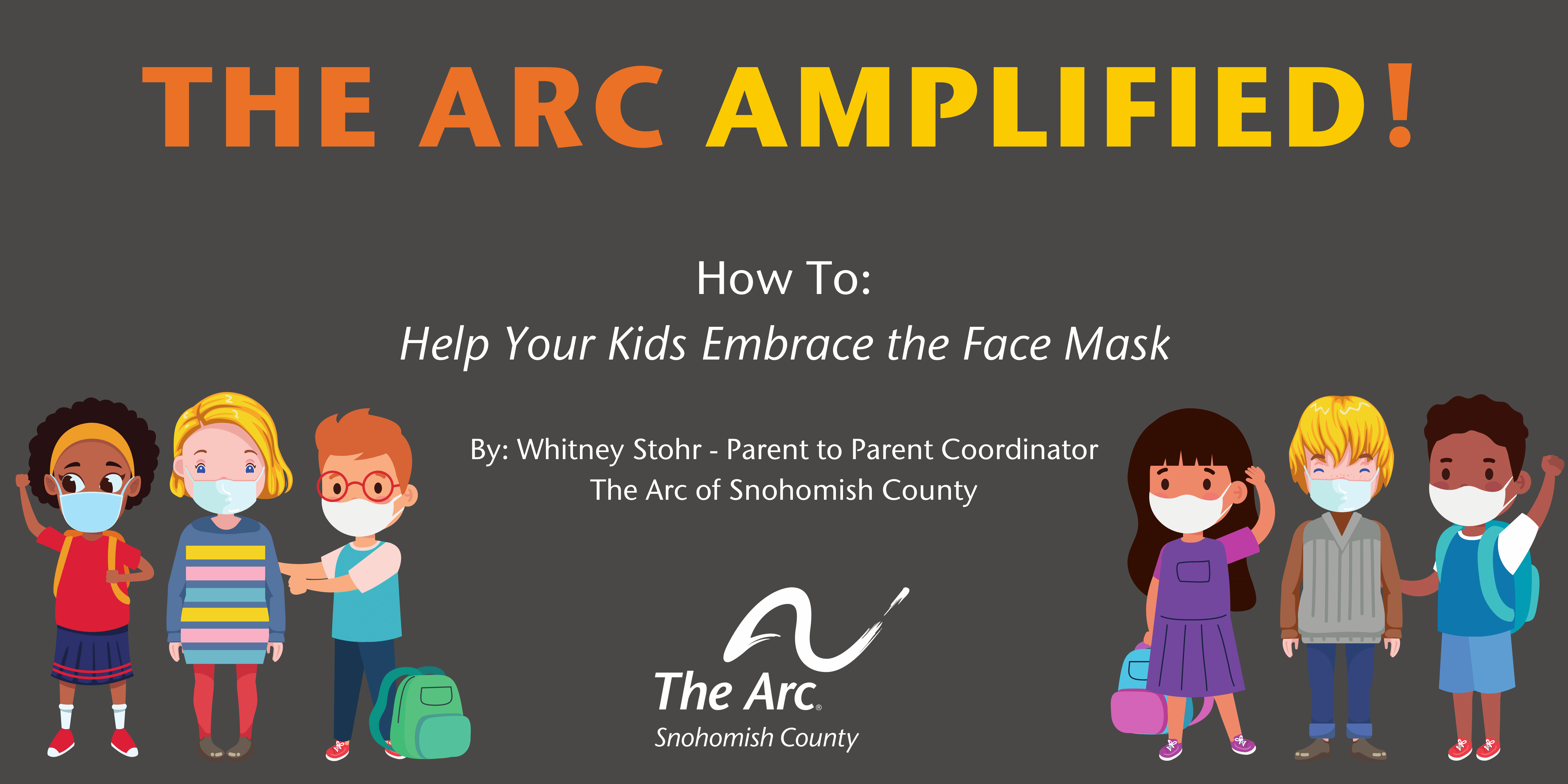
By Whitney Stohr, Parent to Parent Coordinator – The Arc of Snohomish County
Once upon a time, not so very long ago, back in the spring of 2020, we all – with some degree of reluctance and trepidation – accepted the necessity of a facemask. We understood that facemasks would help prevent the continued spread of the COVID-19 virus. We hoped it would be an exceedingly short-lived experience.
Yet, here we are in the autumn months of 2021, some 20 months into this global pandemic, and we still have not reached the point of bidding a final farewell to those masks.
They are still necessary and, in many cases, mandated by state and local health policies.
During these past many months, new babies have been born and toddlers have grown into preschoolers who now must learn to wear a mask of their own. Certainly, as many parents have discovered the hard way, this can be a difficult lesson to impart on our children. And, still, it is as important as ever for parents to continue to talk to their kids about pandemic precautions and to practice wearing face masks.
Listed below are resources that can help parents through discussions with their children around the importance of facemasks, as well as tips to encourage proper wearing of facial coverings.
(Please note: If your child has a disability or significant medical diagnosis, please remember to speak with their healthcare provider about their individual needs.)
*****
Learning to wear a mask can be especially challenging for young children and some youth with intellectual and developmental disabilities. Developed by licensed psychologists at the University of Rochester Medical Center, this toolkit includes helpful tips for parents talking to their children about facemasks, as well as information about items that may help make facemasks more comfortable for children. Read more
“Masks for 7 Hours a Day? How We Can Start Prepping Kids Now”
By Genevieve Shaw Brown / Good Morning America
This article features advice from child development experts, who share their top tips for how parents can teach their kids “mask-wearing best practices,” including ideas to make mask-wearing more fun and turning practice into a game. Read more
Teaching your young child to wear a mask in the proper way for longer durations will take time and focused effort. This resource offers tips on how to best talk to very young children – specifically, toddlers and preschoolers – about wearing masks in public settings. Read more
Video Resources
“Why Do People Wear Masks?” — An interactive song by children’s musician and educator Jack Hartmann
“Heroes Wear Masks” – Story Time with Elmo and Cookie Monster, read by Play & Create
“Put on Your Mask” – Nursery song by Baby Joy Joy – Early Learning
Julia Practices Wearing a Mask: “Fluffster Wears a Mask” – A social story by Sesame Street in Communities
*****
Whitney Stohr is a Parent to Parent Coordinator at The Arc of Snohomish County. She is passionate about advocating for medically complex children and children with disabilities, and their families. She is a mom and medical caregiver herself, who is energized by working closely with other parent/family caregivers. She lives with her three-year-old son Malachi and husband Jason in Lynnwood. Connect with her online at whitney@arcsno.org.
Welcome!
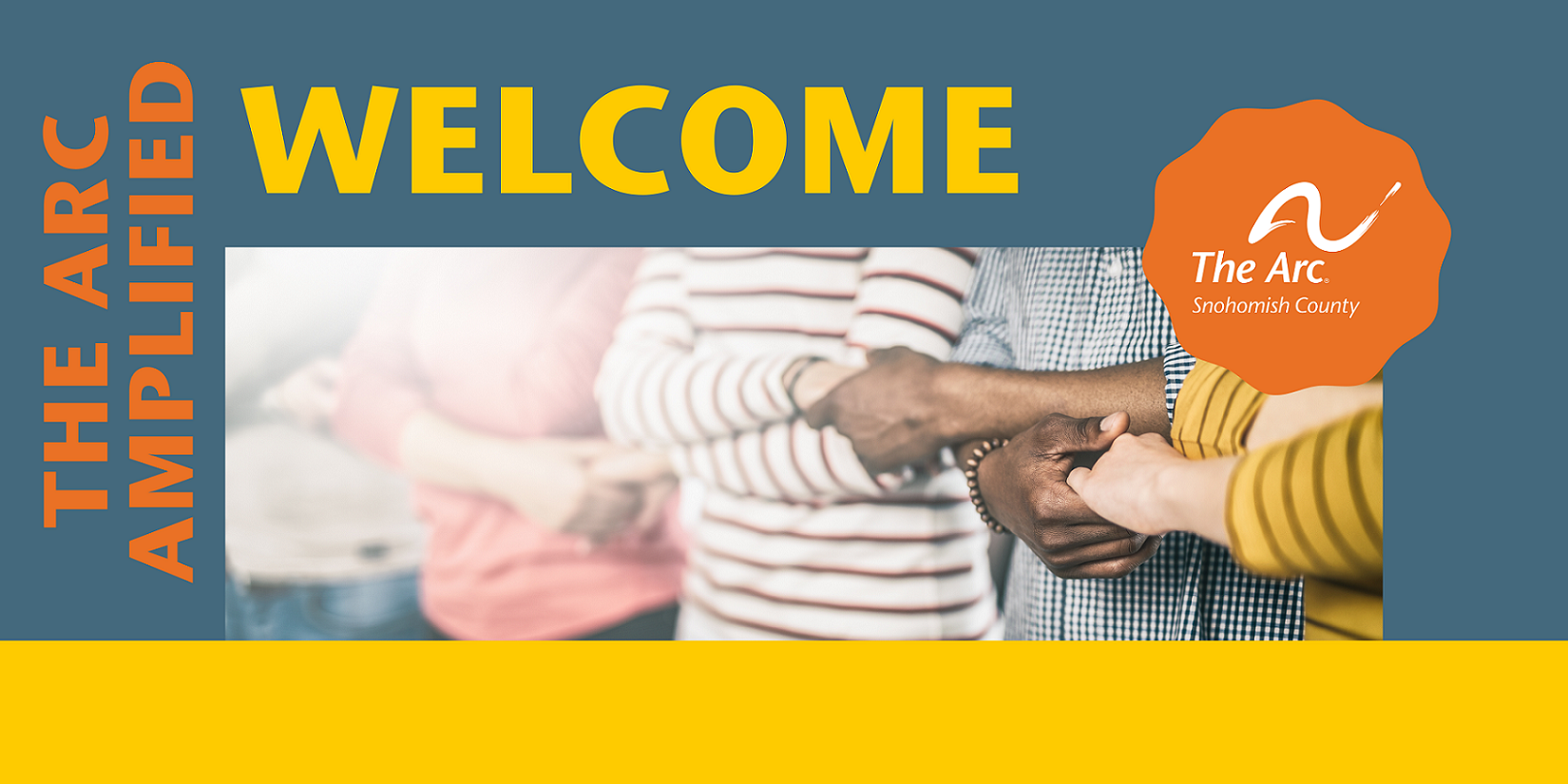
Welcome to The Arc Amplified!
The Arc Amplified is a new online publication and source for sharing stories of inclusion and belonging,
bold activism and local change-makers in action. The mission of this platform is to amplify diverse voices
and “good news” stories from within the disability community in Snohomish County and across the
region.
Do you have a story of inclusion you want to share?
Are you leading local advocacy efforts?
Has your family or loved one benefited from activities or programs in Snohomish County that are
designed to advance community inclusion?
We want to know! Email Whitney Stohr, Parent to Parent Coordinator, at whitney@arcsno.org or call
425-258-2459 x 106.
*
The Arc Amplified is an online publication of The Arc of Snohomish County.
Learn more about our mission and values at arcsno.org.

